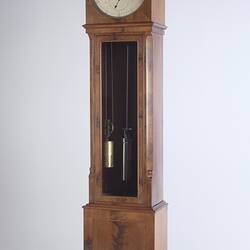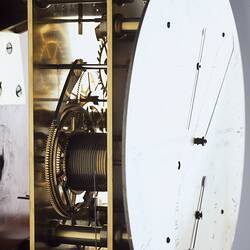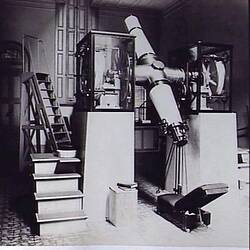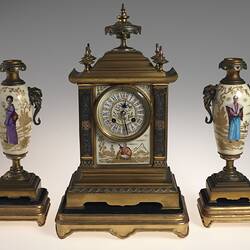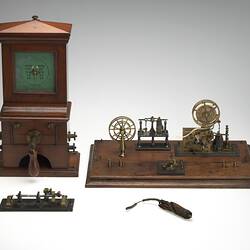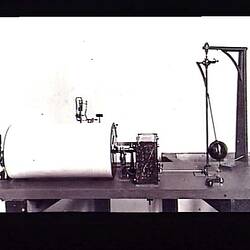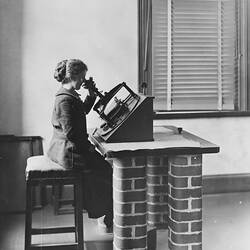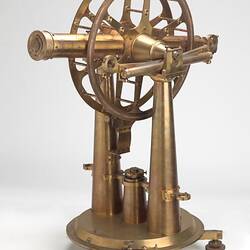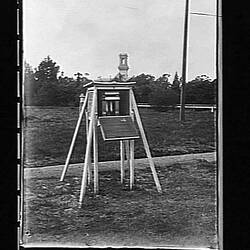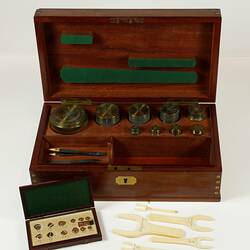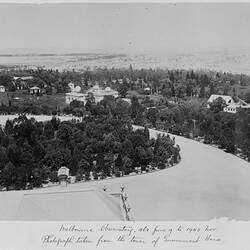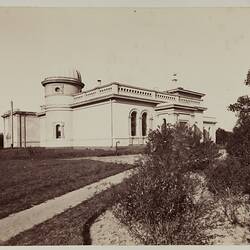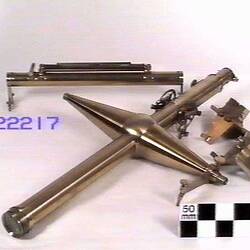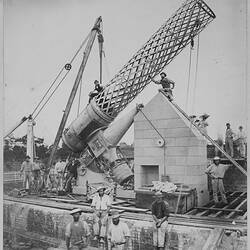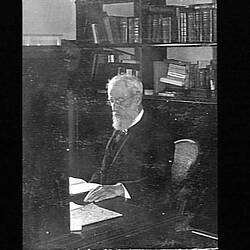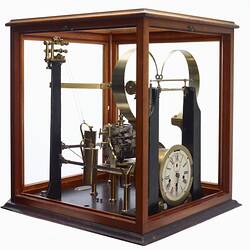Summary
Eight day long-case astronomical regulator clock, by Charles Frodsham, London, No. 1062, 1865. Weight driven, with dead-beat escapement and mercury compensation pendulum. Used at Melbourne Observatory from 1865 until the Observatory closed in 1944.
The Frodsham Regulator was the most important of the scientific clocks used by the Melbourne Observatory in the 19th century. Purchased in 1865, it was linked to telescopes to map the southern hemisphere stars, set Standard Time for Victoria, and establish more precise measurements of Melbourne's longitude.
Physical Description
Wooden case. Main dial denotes minutes. Upper small dial denotes seconds and 24 hour dial sits below. Weight driven with dead-beat escapement and mercury compensation pendulum.
Significance
The Frodsham Regulator was the most important of the scientific clocks used by the Melbourne Observatory in the 19th century. Purchased in 1865, it was linked to telescopes to map the southern hemisphere stars, set Standard Time for Victoria, and establish more precise measurements of Melbourne's longitude.
It was an integral part of the first major international project to map the stars of the southern hemisphere. This was a collaborative project with the observatories at Cape of Good Hope and Madras, and coordinated by the Royal Observatory at Greenwich. The clock was located in the Library and linked electrically to the Second Transit Instrument in the Second Transit Room. By 1871 Government Astronomer Robert Ellery and his second assistant C Moerlin had observed the positions of nearly 50,000 stars. When Ellery visited Britain in 1875, the Astronomer Royal, George Airy, praised Ellery's work, stating publicly that the Melbourne Observatory had published the best catalogue of stars of of the Southern Hemisphere.
In 1883 the Frodsham No 1062 was moved to the new East Transit Room, and connected to the recently installed 8-inch Transit Telescope recently purchased from the London firm of Troughton & Simms. In conjunction with the 8 inch transit telescope and one or two other clocks, the Frodsham No 1062 was used to set Standard Time for the Colony of Victoria. The Frodsham was also involved in fixing the longitude of Melbourne. Recently established telegraphic connections with Greenwich Observatory, via the Overland Telegraph, Darwin and underwater cable, enabled the Observatory in 1883 to undertake a more accurate fixing of Melbourne Observatory's longitude.
The clock was transferred to Mt Stromlo Observatory in 1944, along with the 8-inch transit telescope. The telescope was subsequently sent to Greenwich Observatory, then returned to Melbourne in the 1970s, and is now held in the Museum's collection. The Frodsham No 1062, along with another ex-Melbourne Observatory Frodsham clock, was sold at public auction by Mt Stromlo in 1997. The clock was prevented from being exported under the Commonwealth Government's Protection of Moveable Cultural Heritage legislation.
More Information
-
Collection Names
-
Collecting Areas
-
Acquisition Information
Purchase
-
Acknowledgement
Purchased with the assistance of the Australian Government through the National Cultural Heritage Account.
-
Maker
Charles Frodsham Clockmaker, 84 The Strand, London, Middlesex, England, Great Britain, 1864
-
User
Melbourne Observatory, South Yarra, Greater Melbourne, Victoria, Australia, 1865-1944
-
User
Mr Robert Lewis John Ellery, South Yarra, Greater Melbourne, Victoria, Australia, 1865-1895
-
Inscriptions
Dial marked: 'CHARLES FRODSHAM CLOCKMAKER TO THE QUEEN, NO. 84 STRAND, LONDON' and serial number '1062'.
-
Classification
-
Category
-
Discipline
-
Type of item
-
Overall Dimensions
270 mm (Length), 425 mm (Width), 270 mm (Depth), 1917 mm (Height)
Dimensions when upright with Depth measured from front to back.
-
Keywords
Astronomy, Longcase Clocks, Regulator Clocks, Time Standards, Horology

